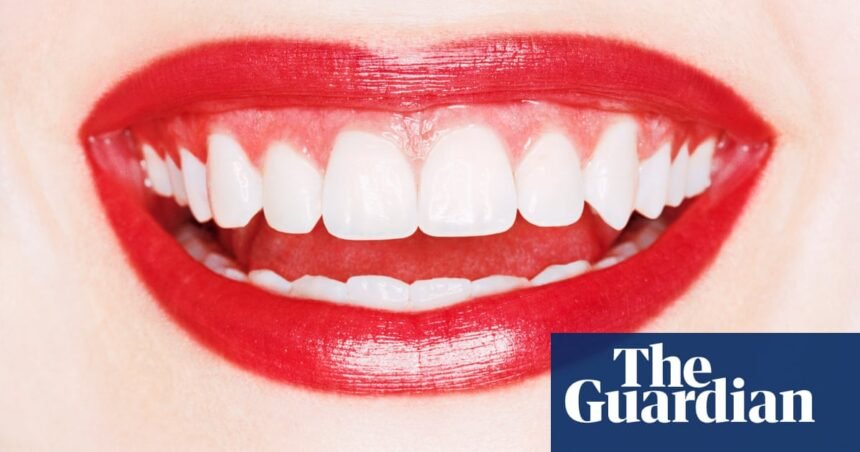Catherine thought she would be making a wise choice by visiting a clinic near Harley Street, a location known for its premium private healthcare. In her early 30s, she aimed to enhance her smile. However, reflecting on her experience—filled with pain, nightmares, and legal costs—she realizes she may have overreacted.
“With hindsight, my teeth weren’t actually that bad,” Catherine (not her real name) states. “They were a bit gappy, which made me lack confidence in photos, often covering my mouth while speaking. Then I came across a voucher deal, and that’s when I decided to go for it.”
The promotion was for veneers, a cosmetic treatment increasingly sought after as cosmetic dentistry gains popularity. Initially considered a means to achieve a “Hollywood smile,” veneers now represent what some refer to as the “Love Island smile,” reflecting the unrealistic perfection seen on reality television and social networks.
Veneers can be crafted from resin or applied similarly to false nails. With costs exceeding £1,000 per tooth, patients can select their desired shade of white, filling gaps or achieving beautifully aligned edges reminiscent of ancient Greek artistry.
Veneers originated in Hollywood, initially used for temporary fixes in the early days of filming, eventually evolving into solid veneers by the 1980s, with the 1990s Hollywood stars setting new standards for perfect smiles. Current trends suggest that veneers have become as common as Botox and lip fillers among those willing to invest in their appearance, with British teeth transforming from their previously infamous status.
“There is a significant demand for veneers, primarily driven by social media’s influence and the desire for symmetrical, white teeth,” explains Anshu Sood, co-owner of Helix House Orthodontics in Nottingham. Sood points out that patients now seek comprehensive transformations beyond just the upper front teeth, referred to as “the social six.”
Sam Jethwa, founder of Bespoke Smile in London and Marlow, has fitted over 10,000 veneers and sees around 80 new consultations monthly, placing about 1,500 veneers annually. He observes a noted increase in male patients and mentions that veneer consultations have quadrupled in the past four years.
Most favor porcelain veneers, which are typically half a millimeter thick and lab-created. Fitting them usually requires minimal tooth preparation, unlike cheaper composite resin options, which can be directly sculpted onto the teeth.
Robbie Hughes, director of Dental Excellence UK in Liverpool, indicates that costs for 20 teeth can range from £7,000 using composites to £20,000 for porcelain veneers. His clientele generally consists of individuals aged 20 to 40, with 40% being male.
A demand for whiter veneers has emerged, as many desire teeth that prominently showcase expensive dental work. Sood highlights that this has altered perceptions of what constitutes “perfect” teeth. While Hughes notices a trend toward more natural shades, he recalls one client, Roberto Firmino, requesting an excessively white shade.
The pandemic has spurred greater demand for veneers, driven by self-reflection during home working periods. However, many practitioners are competing on price, leading to less skilled operators mitigating increased demand through aggressive marketing.
Catherine’s initial deal for veneers greatly reduced her costs. Impressed by the clinic’s ambiance and the dentist’s apparent expertise, she secured a consultation and underwent the procedure over a few hours. Unfortunately, the dentist removed too much from her teeth, leaving her with pegs instead of natural tooth structure. Following the veneer application, her mouth wouldn’t close, prompting the dentist to further reshape her bottom teeth.
“I was hysterical. I couldn’t stop crying,” Catherine shares. “I realized I had made the biggest mistake of my life.” After the anesthetics wore off, eating became difficult. Eventually, her veneers fell off, revealing the unsightly pegs beneath. Fearing high repair costs, she returned to Harley Street for adjustments, but issues worsened when one veneer shattered during a meal.
Her new dentist was shocked by the state of her teeth and revealed that the wrong adhesives and materials had been used originally, leading to a disastrous outcome. Taking pity on her, he agreed to redo the veneers at a reduced price. When Catherine sought a refund from her initial dentist, she reached out to Russell Sutton, a solicitor who has garnered attention for representing victims of cosmetic dentistry mishaps.
“Some dentists are tempted to take money from young patients, doing subpar work for quick cash,” notes Sutton, founder of TJL Solicitors.
Christopher Dean, a former dentist now working in legal aid, mentions that his firm receives about five inquiries weekly regarding poorly fitted porcelain veneers, a 30% increase from the previous year.
Inquiries to the General Dental Council (GDC) regarding dissatisfied patients have also surged, doubling from roughly 2,000 in 2018 to about 4,000 in 2022.
Sutton is representing Catherine but warns that obtaining compensation can be challenging. They operate on a no-win, no-fee basis, selecting cases likely to yield substantial payouts, contingent on the dentist’s insurance coverage.
Regrettably, dentists in the UK are generally reluctant to take on patients with poor treatment experiences abroad. Turkey has become a hub for cosmetic procedures, with veneers advertised for as little as €100 each, alongside vacation packages.
Some well-known figures fueling the “Turkey teeth” trend have expressed regret over their choices. Reality television star Jack Fincham, who won Love Island in 2018, later confessed to insufficient research when getting his smile done in Turkey.
The distinction between veneers and more invasive crowns is often misunderstood, and while crowns can effectively treat badly damaged teeth, they also risk significant alterations that may harm the tooth’s health.
Despite the horror stories, many patients delight in their veneers. Neil Fowler, who enhanced his “social six” in Brighton, felt a boost in confidence after transitioning from crooked, yellow teeth to a radiant smile.
Patients facing issues typically turn to their local NHS dentist. The NHS is obligated to address urgent situations related to deteriorating teeth, though not for cosmetic enhancements. NHS officials acknowledge an uptick in demand stemming from poor overseas treatments, adding unforeseen pressure on their services.
Even optimal treatments can leave patients needing costly replacements over time. A well-maintained porcelain veneer can last 15 to 20 years, while cheaper composites might start failing after just a few.
Catherine ultimately took over a year to receive compensation from her dentist’s insurance. Although she’s not wealthy, she’s relieved to know she can afford replacements in the future and is glad her dentist lost their license due to unrelated malpractice.
Yet her traumatic experience lingers. “I think I’ve got PTSD from it all,” she admits. “Even now, I won’t bite into food and I have nightmares of losing my teeth. I’m really angry about the whole situation.” She enjoys her smile now but cautions friends considering veneers to think carefully. “Once they’re gone, they’re gone.”





